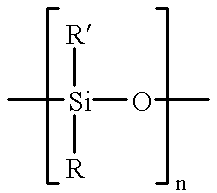Durable press/wrinkle-free process
a cellulosic fiber and durable press technology, applied in weaving, synthetic resin layered products, physical treatment, etc., can solve the problems of inability to reproduce, cost and unsatisfactory, and the known process has not been encountered. , the process of durable press is not completely satisfactory and low-cost formaldehyde is not yet satisfactory
- Summary
- Abstract
- Description
- Claims
- Application Information
AI Technical Summary
Problems solved by technology
Method used
Image
Examples
example 1
[0045] As indicated, it is possible to cure with a high enough temperature that the crosslinking reaction is achieved before sufficient formaldehyde is lost preventing good treatment. In this experiment, 100% cotton oxford shirting was padded with formaldehyde (37%) at a concentration of 5.0% OWF, 0.8% OWF of Freecat #9 Accelerator manufactured by Freedom Textile Chemicals Co. and 1.5% OWF of a silicone elastomeric softener, Sedgesoft ELS manufactured by Sedgefield Specialties, to a pickup of approximately 60-70%. The sample was then dried and cured while under tension in an air circulating oven set at 300.degree. F. for 10 minutes.
example 2
[0046] Another sample of the same fabric as used in Example 1 was padded with a similar solution differing only in that the catalyst Accelerator #9 was 1.0% OWF. Otherwise the sample was treated precisely the same.
example 3
[0047] Another sample of the same fabric as used in Example 1 was padded with a similar solution differing only in that the catalyst Accelerator #9 was 2.0% OWF. Otherwise the sample was treated precisely the same.
PUM
| Property | Measurement | Unit |
|---|---|---|
| Fraction | aaaaa | aaaaa |
| Fraction | aaaaa | aaaaa |
| Fraction | aaaaa | aaaaa |
Abstract
Description
Claims
Application Information
 Login to View More
Login to View More - R&D
- Intellectual Property
- Life Sciences
- Materials
- Tech Scout
- Unparalleled Data Quality
- Higher Quality Content
- 60% Fewer Hallucinations
Browse by: Latest US Patents, China's latest patents, Technical Efficacy Thesaurus, Application Domain, Technology Topic, Popular Technical Reports.
© 2025 PatSnap. All rights reserved.Legal|Privacy policy|Modern Slavery Act Transparency Statement|Sitemap|About US| Contact US: help@patsnap.com

